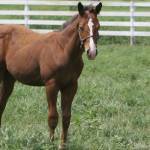Successful Weaning of Foals: Keep Them Eating

Weaning a foal from its dam can prove to be a high-anxiety event. The separation is often accompanied by nonstop whinnying, stall- or fence-walking and, worst of all, an unwillingness to eat. Though interest in feed usually returns once the foal has settled, owners can ready a foal for weaning by following a few management strategies.
Accustom foals to concentrates, such as textured or pelleted feed, prior to weaning. This is typically not a problem for those foals whose dams receive concentrates to maintain body condition during lactation, as foals usually dive into feed tubs several weeks after birth. “This step is more important for foals born to easy keepers, as these mares might not be given concentrates during lactation. If necessary, tie mares and allow foals to eat concentrate once or twice a day,” explained Catherine Whitehouse, M.S., a nutrition advisor with Kentucky Equine Research (KER).
Choose a well-formulated feed intended for young horses. Different feeds are created for various life stages, and growth formulas contain different amounts of vitamins, minerals, and other nutrients required for sound growth. “When fed products intended for older horses, some young horses do not reach their genetic potential in terms of size,” added Whitehouse, “which is why it’s important to offer an age-appropriate feed to weanlings.”
Offer at least the minimum amount of feed recommended by the manufacturer. Though manufacturers will typically provide a feeding range, the minimum will include the nutrients required for proper development. More feed can be given if calorie needs warrant. Simply put, a weanling in heavy or moderate flesh should be fed on the lower end of the recommendations, and a weanling in light condition should be fed on the upper end. Weanlings should not be fed to obesity, as this increases the risk of growth problems, such as physitis and potentially osteochondritis dissecans (OCD), according to Whitehouse. Consider taking a critical look at body condition of weanlings every week or two to keep weight in check.
As with concentrates, familiarize foals to good-quality hay. Depending on the environment in which foals are born and raised, some foals might not have been exposed to hay prior to weaning. Imagine, for example, if a foal was born in a grassy paddock and then introduced into a herd that was maintained on high-quality pasture. Because pasture provided adequate forage for mature horses, the foal was likely not given access to hay. It is best to familiarize foals with hay before weaning, if possible.
Give special consideration to stall-bound foals. For foals maintained in stalls or small runs, consider adding DuraPlex to the ration. “When young horses do not have access to wide-open spaces to run and play, skeletal health suffers,” Whitehouse said, “as it is the day-to-day, constant concussion that makes bone dense and resilient.” DuraPlex provides weanlings, yearlings, and older horses with the nutrients necessary to keep bone strong and optimally mineralized during periods of confinement. DuraPlex is available in the U.S. and other markets; in Australia, look for Bone Food Plus.
Properly nourishing a weanling can be tricky, so turn to an expert in equine nutrition if a problem arises. The nutrition advisors at KER are available for consultation. Start a diet evaluation now.








